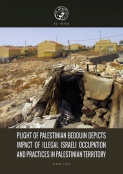The Bedouin were from the Jahalin tribe. They originally made their home in the Negev, where they lived their nomadic life in tents, raising their goats and occasionally occupying themselves with seasonal agriculture. In 1950 the Israeli army pushed them out and they re-established themselves at the edge of the wilderness, just by Jerusalem, on land belonging to the Arab tribe of Abu Dees. They continued living in their tents, moving eastward in Winter to a warmer region, where they stayed until early spring, leaving only after their goats had given birth and the young had grown big enough to move on. But when in 1976 a handful of Israeli settlers founded the new settlement of Maaleh Adumin, the Jahalin had to be evicted again. They put up a protracted struggle to hold on to the land where they had been living for over two decades. The case went to the Israeli High Court, which, as usual, after taking its time, produced a long carefully drafted impressive decision that favoured the state.
The predicament of the Palestinian Bedouin in the Occupied Palestinian Territory (OPT) is symptomatic of the plight of many Palestinians under the illegal Israeli occupation. Since the Declaration of Principles of the Oslo Accords 1993, the territorial integrity of the West Bank and the Gaza Strip has been increasingly fractured. In accordance with the Interim Agreement following the Oslo Accords, the West Bank and Gaza Strip were divided into three different administrative zones: Area A, Area B and Area C. In Area A, the Palestinian Authority exercises most control compared with other areas and this represents around 18% of the West Bank; Area B comprises around 22% of the West Bank. Area B encompasses most villages and towns where civil affairs are managed by the Palestinian Authority with the Israeli military authority having control of security. Area C corresponds to around 60% of the West Bank where the Palestinian Authority has no authority. Except for Hebron and its hinterland, much of Area C is sparsely populated. The UN Office for the Co-ordination of Humanitarian Affairs estimates that some 300,000 Palestinians live in Area C, under full Israeli civil and military control.



